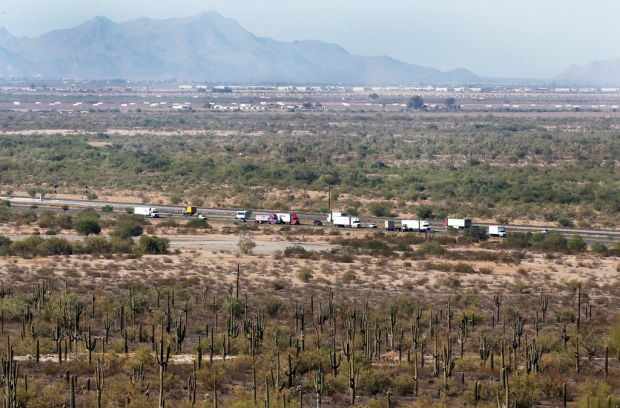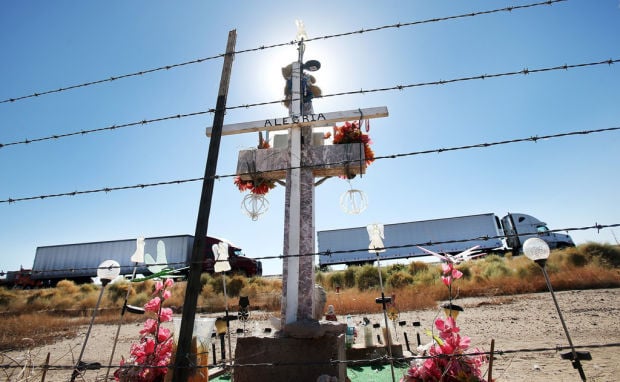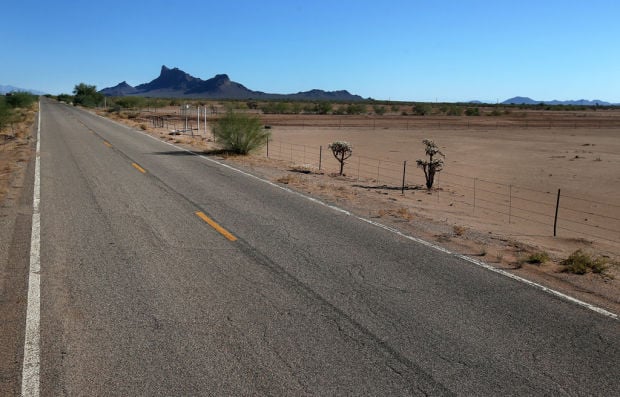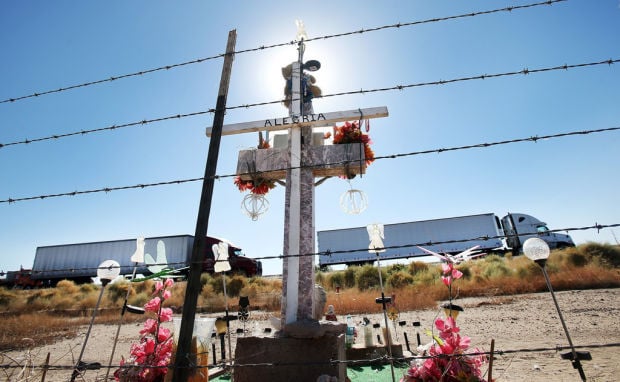A two-mile stretch near Picacho Peak is the deadliest portion of Interstate 10 in Arizona, killing at least eight people in more than 50 crashes since 2000.
The most recent crash, caused by a dust storm that popped up without warning, killed three people there on Oct. 29.
“People are going to die in the future as well,” said Sen. Steve Farley, D-Tucson, who was caught in the storm.
The danger is most acute at mileposts 214 and 213, north of Picacho Peak and south of Eloy, a Star analysis of state data shows.
The problem is caused by former farmland that has slowly returned to desert, but with little in the way of shrubs or grass to catch blowing dirt.
A sudden gust can stir up a dust cloud that completely obscures vehicles without warning, said Capt. Brian Preston, who runs the Casa Grande office of the Arizona Department of Public Safety and has been stationed in the area since 2011.
Even the safest drivers can find themselves instantaneously in a perilous situation, Preston said. But many plow through a dust storm without taking even basic precautions. A video he shot in 2011 along Interstate 8 near Casa Grande shows cars and trucks failing to even step on their brakes for him while his lights are on. They fly down the freeway at 75 mph – possibly faster – into a wall of dust that is impossible to see through.
ADOT at a “dead End”
Steps to lessen the risk of dust storms between Marana and Casa Grande have been slow.
Steve Christy began pushing the Arizona Department of Transportation to address dust-related crashes shortly after he was appointed to the State Transportation Board in 2009.
He said after the Oct. 29 crash that ADOT is working on its warning systems and education but “reached a dead end” when it came to the condition of the land along the interstate that is in a mix of public and private hands.
“In my estimation, ADOT has gone as far as it can jurisdictionally and legislatively to address the problem,” he said.
Christy suggested legislative action on the issue and Farley said he agrees.
In the meantime, the Transportation Department will place several cameras along I-10 in coming months, including a set of cameras near the particularly dusty milepost 214, said Rob Samour, senior operations engineer.
The cameras will monitor live traffic, but Samour hopes the resolution will be good enough to spot dust storms along the busy stretch of Interstate 10.
The department also is coordinating with the National Weather Service to put out portable signs warning drivers of possible dust storms during windy days. Another option, Samour said, is to have DPS slow traffic along the Interstate.
Local DPS officers are already moonlighting as weather monitors, calling in unusual weather directly to the National Weather Service.
The problem demands a systems approach, said Thomas Horrigan, a senior principal systems engineer at Raytheon Missile Systems in Tucson.
Horrigan said he and some engineer friends have volunteered to work on a solution. He said he offered his services two years ago and reiterated that in a recent email to Christy.
“Obviously, the first step is to try to prevent the dust from being a factor,” he said. “If you can’t mitigate it, then you have to be able to sense what’s going on, communicate to the right people what’s going on and have a process or procedure to get that word out.”
Horrigan also said “that stretch is really heavily laden with tractor trailers. We need to understand how they contribute to the problem.”
Farley can offer a hint about that. During last month’s storm he witnessed a crash that occurred “when an 18-wheeler came plowing through at full speed.”
Dustiest place in country
Milepost 214, where Farley was stopped, is where the interstate cuts through the dustiest stretch of degraded desert in a county the EPA identified in 2006 as the dustiest place in the country.
A comprehensive analysis of Arizona’s entire length of I-10 between the California and New Mexico borders shows a 10-mile area near Picacho Peak is the deadliest. A decade worth of data, the most recent available, shows 37 crashes between 2001 and 2010, statistics compiled by the Arizona Department of Transportation show.
There were 141 dust-caused crashes on the 70-mile stretch between Marana and Casa Grande in that same time period.
This data does not include more recent crashes, including the Oct. 29 triple-fatality, that further pinpoint the two-mile stretch as deadliest.
In the grand scheme of things, that’s a tiny percentage of crashes on state and federal highways in Arizona. But because dust storms come on suddenly, they’re difficult to forecast. And because the storms block visibility on a fast-moving roadway, they are deadly and disruptive, involving large numbers of vehicles and impeding travel for hours.
Avelino Arellano, a UA assistant professor of atmospheric sciences, recently submitted a grant proposal to the National Oceanic and Atmospheric Administration for a three-year study that would produce a new model and build weather stations to be deployed in dust-prone areas along interstate highways in Arizona.
The stations would measure everything from wind speed to soil moisture and could lead to pinpoint forecasts for a given area, said J.J. Brost, a science officer for the National Weather Service in Tucson, who is working on the plan to improve dust forecasting in the region. The Weather Service issues wind advisories when certain conditions are present, Brost said, but recent crashes have occurred on days when the advisories were not warranted.
“The challenge is you don’t want to cry wolf,” he said. “People will ignore the message if every single day you say there is going to be dust.”
Former farmlanD
Much of the land in the dusty corridor is former farmland, abandoned decades ago by farmers who lacked water rights to irrigate it, said Rick Gibson, head of agricultural extension for Pinal County.
“That whole area, from Picacho Peak west to Casa Grande, particularly around Eloy, Toltec and Arizona City, that is the prehistoric and historic terminus of the Santa Cruz River.”
Farmers diverted the river’s flow in the early 1900s to irrigate fields, Gibson said. The land was irrigated through the 1950s, then farmers started to run out of water and abandoned their fields.
“There are places along that entire freeway stretch where even the slightest breeze can pick that stuff up and make a short-term visibility problem,” he said.
Desert soil that has been broken by plow does not recover quickly, said David Breshears, a professor of natural resources at the University of Arizona. And dust blows freely when the plants are gone.
“Vegetation matters, and a little goes a long way,” said researcher Jason Field, who studied blowing dust experimentally on desert land south of Tucson.
A single shrub can stop 60 percent of the dust that passes through it, Field said. Even grass can significantly reduce dust substantially.
“Bare patches actually serve to amplify the amount of dust,” he said. “You get an avalanche effect.”
Irrigation also leaves behind salts, making it difficult to revegetate, Breshears said. “Irrigated desert that doesn’t drain well builds up salts. They accumulate and destroy soil texture.”
Trying to “light a fire”
It is time to stop talking about what can’t be done to control dust and do something, Farley said — particularly along this one deadly stretch of highway.
Getting caught in the recent fatal dust storm “was pretty terrifying,” he said. “All of a sudden it’s upon you and you can’t see a thing.” Traffic slowed and stopped in the eastbound lanes. He waited out the storm listening to a series of crashes across the median in the westbound lanes.
Farley doesn’t know if the answer is to revegetate land or to build physical barriers — but he’s certain something can be done.
He contacted officials at ADOT after the crash and was told they were working on a number of ways to mitigate the threat. He said he wants to see a list — and some movement.
“I’m gonna light a fire,” he said.







